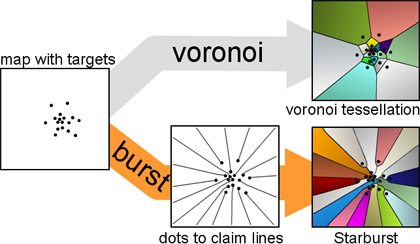starburst |
microsoft research |
|
up patrick baudisch |

|
(top path)
Traditional snap-to-target techniques expand targets into
immediately adjacent space. For targets located inside a cluster,
however, that expansion is minimal. (bottom path) The proposed Starburst algorithm connects targets to peripheral screen space to produce reasonably sized tiles for all targets, including those located inside a target cluster. |
Acquiring small targets on a tablet or touch screen can be challenging. To address the problem, researchers have proposed techniques that enlarge the effective size of targets by extending targets into adjacent screen space. When applied to targets organized in clusters, however, these techniques show little effect because there is no space to grow into. Unfortunately, target clusters are common in many popular applications. We present Starburst, a space partitioning algorithm that works for target clusters. Starburst identifies areas of available screen space, grows a line from each target into the available space, and then expands that line into a clickable surface. We present the basic algorithm and extensions. We then present 2 user studies in which Starburst led to a reduction in error rate by factors of 9 and 3 compared to traditional target expansion.
or download the video
![]() WMV
(8.7M)
WMV
(8.7M)
|
|
Baudisch, P., Zotov, A., Cutrell,
E., and Hinckley, K. |
In collaboration with Alex Zotov, Ed Cutrell, and Ken Hinckley